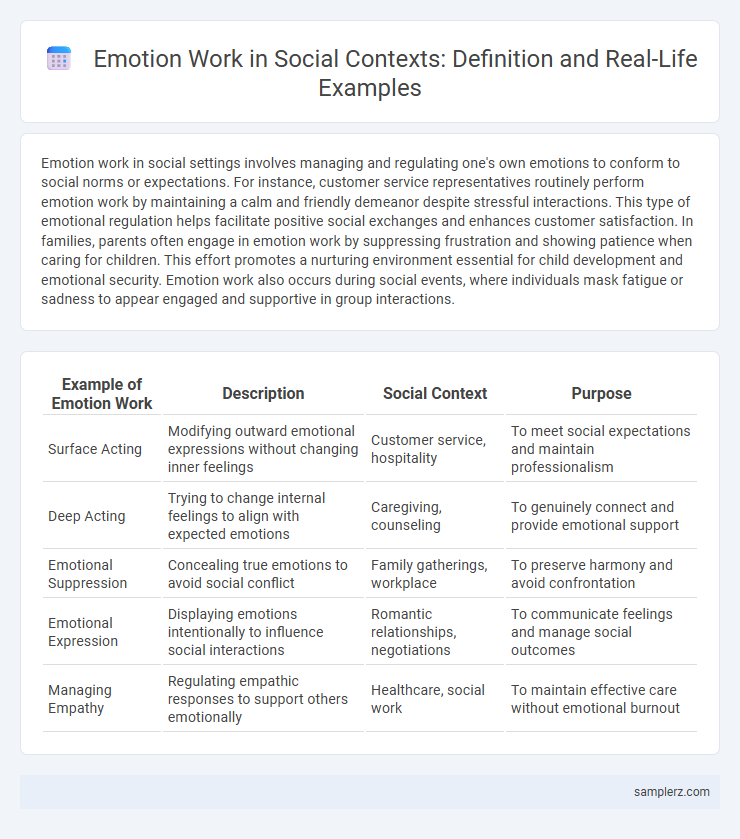Emotion work in social settings involves managing and regulating one's own emotions to conform to social norms or expectations. For instance, customer service representatives routinely perform emotion work by maintaining a calm and friendly demeanor despite stressful interactions. This type of emotional regulation helps facilitate positive social exchanges and enhances customer satisfaction. In families, parents often engage in emotion work by suppressing frustration and showing patience when caring for children. This effort promotes a nurturing environment essential for child development and emotional security. Emotion work also occurs during social events, where individuals mask fatigue or sadness to appear engaged and supportive in group interactions.
Table of Comparison
| Example of Emotion Work | Description | Social Context | Purpose |
|---|---|---|---|
| Surface Acting | Modifying outward emotional expressions without changing inner feelings | Customer service, hospitality | To meet social expectations and maintain professionalism |
| Deep Acting | Trying to change internal feelings to align with expected emotions | Caregiving, counseling | To genuinely connect and provide emotional support |
| Emotional Suppression | Concealing true emotions to avoid social conflict | Family gatherings, workplace | To preserve harmony and avoid confrontation |
| Emotional Expression | Displaying emotions intentionally to influence social interactions | Romantic relationships, negotiations | To communicate feelings and manage social outcomes |
| Managing Empathy | Regulating empathic responses to support others emotionally | Healthcare, social work | To maintain effective care without emotional burnout |
Understanding Emotion Work in Social Settings
Emotion work in social settings involves managing feelings to meet social norms and expectations, such as caregivers providing comfort to patients despite personal stress. This process requires self-awareness and empathy to navigate interpersonal dynamics effectively, ensuring emotional expressions align with situational demands. Understanding emotion work enhances social cohesion by fostering trust and positive interactions in diverse environments.
The Role of Emotion Work in Friendships
Emotion work in friendships involves managing and expressing feelings to maintain social harmony and support. Acts such as offering empathy during difficult times, regulating personal emotions to avoid conflict, and providing reassurance enhance trust and deepen relational bonds. This continuous emotional regulation sustains mutual understanding and strengthens friendship resilience.
Emotion Work within Family Dynamics
Emotion work in family dynamics involves managing and regulating emotions to maintain harmony and support among members. Parents often engage in empathy and emotional coaching to help children understand and express feelings appropriately. Siblings participate in conflict resolution by negotiating emotions to preserve relationships and foster a cooperative environment.
Navigating Emotion Work in Romantic Relationships
Navigating emotion work in romantic relationships involves managing one's own feelings while responding empathetically to a partner's emotional needs. Partners often engage in activities such as active listening, providing emotional support, and regulating expressions of affection to maintain harmony and connection. This ongoing emotional labor strengthens relational bonds and contributes to emotional intimacy and mutual understanding.
Emotion Work in Workplace Interactions
Emotion work in workplace interactions involves managing and regulating feelings to meet organizational expectations, such as displaying positivity during customer service or maintaining composure in high-stress meetings. Employees often engage in surface acting, where they fake emotions, or deep acting, where they genuinely attempt to feel the required emotions, to foster a professional environment. This emotional labor influences job satisfaction, performance, and interpersonal relationships within social dynamics at work.
Emotion Work during Social Gatherings
Emotion work during social gatherings involves managing and expressing feelings to maintain group harmony and positive interactions. Participants often regulate their emotions by showing enthusiasm, empathy, or restraint to meet social expectations and support relational dynamics. This intentional modulation of emotions helps sustain social bonds and enhances overall group cohesion.
Managing Conflict through Emotion Work
Managing conflict through emotion work involves regulating one's own emotions to de-escalate tense situations and promote constructive dialogue. By consciously expressing empathy, frustration can be diffused and understanding can be fostered between conflicting parties. Effective emotion work in social settings enhances communication, reduces hostility, and supports conflict resolution.
The Impact of Emotion Work on Social Support Networks
Emotion work, the management of feelings to influence others' emotions, significantly shapes social support networks by fostering empathy and trust among members. Consistent emotion work enhances relational quality, promoting resilience and mutual assistance during hardships. Neglecting emotion work can weaken social ties, reducing the effectiveness of support systems in times of need.
Gender Differences in Social Emotion Work
Gender differences in social emotion work reveal that women often engage more frequently in managing emotions to maintain social harmony and support relationships. Studies show women perform a higher proportion of empathetic listening and emotional caregiving in both professional and personal contexts. Men typically exhibit emotion work through problem-solving and controlling emotional expressions to conform to societal expectations of masculinity.
Strategies for Effective Emotion Work in Social Life
Effective emotion work in social life involves consciously managing feelings to maintain positive interactions and social harmony. Strategies such as cognitive reappraisal, where individuals reframe a situation to alter emotional impact, and expressive suppression, which involves controlling outward emotional expressions, are commonly employed. Consistent practice of these techniques enhances emotional regulation, fostering empathy and stronger interpersonal connections.

example of emotion work in social Infographic
 samplerz.com
samplerz.com